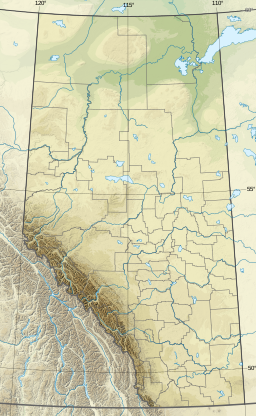
Back Lake Louise (lanaw sa Kanada, Alberta, lat 51,41, long -116,23) CEB Lake Louise (Alberta) Czech Луиз (кӳлĕ) CV Lake Louise German Lago Louise Spanish دریاچه لوئیز (آلبرتا) Persian Lac Louise (Alberta) French אגם לואיז HE Danau Louise ID レイク・ルイーズ Japanese
| Lake Louise Ho-run-num-nay | |
|---|---|
 Lake | |
| Location | Banff National Park, Alberta |
| Coordinates | 51°24′42″N 116°13′41″W / 51.41167°N 116.22806°W |
| Type | Glacial Lake |
| Primary inflows | Lefroy Glacier |
| Primary outflows | Louise Creek |
| Basin countries | Canada |
| Max. length | 2.0 km (1.2 mi) |
| Max. width | 0.5 km (0.31 mi) |
| Surface area | 0.8 km2 (0.31 sq mi) |
| Max. depth | 70 m (230 ft) |
| Surface elevation | 1,750 m (5,740 ft) |
| Settlements | Lake Louise |
Lake Louise (named Ho-run-num-nay (Lake of the Little Fishes) by the Stoney Nakoda First Nations people)[1][2] is a glacial lake within Banff National Park in Alberta, Canada. Situated 11 km (6.8 mi) east of the border with British Columbia, Lake Louise is located 5 km (3.1 mi) west of the hamlet of Lake Louise and the Trans-Canada Highway (Highway 1).
Lake Louise was well known and visited by Indigenous Peoples prior to the arrival of the Canadian Pacific Railway survey crews in the 1880s. Thomas Edmonds Wilson was the first non-Indigenous person to visit the lake, having being led there by a Stoney Nakoda guide named Edwin Hunter in 1882.[3] Wilson named the lake "Emerald Lake" and promoted it as a development opportunity, although the lake was later renamed to Lake Louise.
Lake Louise is named after the Princess Louise Caroline Alberta (1848–1939),[4] the fourth daughter of Queen Victoria and the wife of the Marquess of Lorne, who was the Governor General of Canada from 1878 to 1883.
The turquoise colour of the water comes from rock flour carried into the lake by melt-water from the glaciers that overlook the lake. The lake has a surface of 0.8 km2 (0.31 sq mi) and is drained through the 3 km long Louise Creek into the Bow River.
Fairmont's Chateau Lake Louise, one of Canada's grand railway hotels, is located on Lake Louise's eastern shore. It is a luxury resort hotel built in the early decades of the 20th century by the Canadian Pacific Railway.
Moraine Lake and Lake Agnes are also accessible from Lake Louise.
- ^ "Banff National Park: Lake Louise & Moraine Lake". Parks Canada. 2018-10-10. Retrieved 2018-10-10.
- ^ "Chateau Lake Louise". www.thecanadianencyclopedia.ca. The Canadian Encyclopedia. Retrieved 5 August 2020.
Lake Louise was originally known to the local Stoney-Nakoda people as Ho-run-num-nay, or the "Lake of Little Fishes."
- ^ Wilson, Thomas E. (1972). Trail Blazer of the Canadian Rockies. Calgary, Alberta: Glenbow-Alberta Institute. pp. 29–30.
- ^ "Princess Louise Caroline Alberta - Alberta Centennial". www.albertacentennial.ca. Archived from the original on 2012-03-11.
